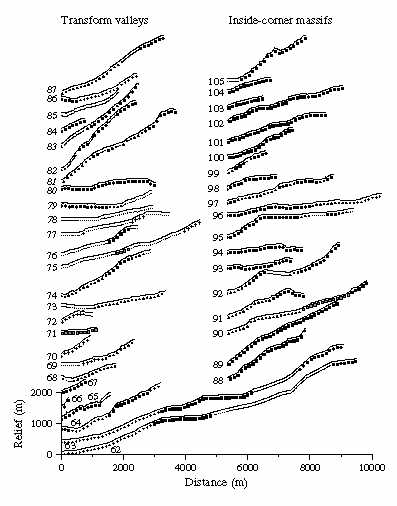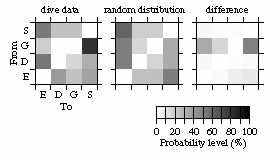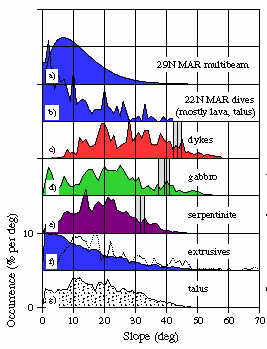Over the last 3 decades, submariners have dived many times on the world's mid-ocean ridges to collect highly detailed
observations revealing the volcanic, tectonic and geothermal processes operating in these interesting areas. This information
has previously been held in disparate data repositories and reported in different ways that make it
difficult to draw general conclusions. The observations have typically been presented
in published reports with different vertical exaggeration and with
different illustrative style. In order to make comparisons between different areas easier, the observations and
sample descriptions published by the scientists were combined to form a numerical database of topography
along each dive transect and a classification of the rock types observed. An example
of part of the database, for dives within or adjacent to transform valleys, is shown to the right
(solid circles, for example, show where
pillow lava was observed). These graphs allow the slopes and scarp shapes to be compared
between areas. To obtain a copy of this database, please follow this link.
This database was used for two projects:
|

|
Random sequences of lithologies on rock slopes of the Mid-Atlantic Ridge
According to the classical "Penrose" model, the oceanic crust is layered with extrusive rocks (pillow lava, etc) overlying dykes,
gabbro and peridotite in turn. Where large normal faults expose sections of a layered crust, we might expect to find
pillow lava outcropping above dykes, and dykes occasionally above gabbro and serpentinised peridotite if fault heave is large enough. It has
been known for a number of years that this simple conceptual picture is wrong for slow-spreading ridges, since
dredges often recover a higher abundance of deep rocks (serpentinite and gabbro) than expected and all
the different lithologies can be found at any depth level on escarpments. This study quantified the
heterogeneity represented by the dive observations and showed that the net effect of processes at a slow-spreading ridge
is to produce a random arrangement of rock types.

|
Using the Mid-Atlantic Ridge dive data, the transitions between lithologies encountered on each rock slope were counted to develop
transition probability tables. These show the relative likelihood of passing from one reference lithology
to each of the others. The figure on the left (left-most graph below) was calculated from all the dives in the
Atlantic, where grey levels represent the relative probability of passing from the lithology
given on the left to the lithology listed along the bottom. (E=extrusives, D=dykes, G=gabbro,
S=serpentinite.) The bottom row in that graph, for example, shows that transitions from E most
commonly lead to D, second commonly to S and least commonly to G.
The middle table was predicted from a purely random
distribution of rock types (in this case the chance of passing into G from E, for example,
then merely reflects the abundance of units of G compared to D and S). The graph on the
far right shows the difference of the data and model, and reveals that they are very
similar (the differences for G reflect small sample size and are not significant).
Thus, the rock types exposed on escarpments of the slow-spreading Mid-Atlantic Ridge are not organised in any particular
characteristic order. This reflects the well-known heterogeneity of slow-spreading oceanic crust produced
by complex tectonic, volcanic and sedimentary processes at the ridge.
(Abstract and full article (PDF)*.)
|
Rock slope geomorphology

|
It is commonly assumed that some massive rock types, such as gabbro, can attain steep slopes on the
seafloor where they are exposed along fault escarpments, whereas more
highly fractured and friable lithologies such as pillow lava
tend to form less gently inclined outcrops. It might be supposed that the morphology of the seafloor,
recorded with sonar systems, could be used as a guide to the underlying geology.
With a view to testing whether different strength properties of
lithologies limit outcrop slope
on the seafloor, the figure on the left shows histograms of their slope angles.
Interestingly, serpentinite
very rarely outcrops with slopes steeper than 40 degrees, whereas slopes of gabbro and dykes steeper
than 40 degrees are common. The shallower maximum slope of serpentinite could reflect the rock's weak
geotechnical properties (surfaces have low coefficients of friction, i.e. are slippery), jointing or its
geological environment (serpentinite is commonly exposed
by low angle faults, thus leading to low gradients of outcrops on the seafloor). Apart from the limited slope of serpentinite, however, the rock types
don't have significantly different slopes in general, so seafloor morphology is likely to
be a poor guide to the underlying geology. Abstract
|


